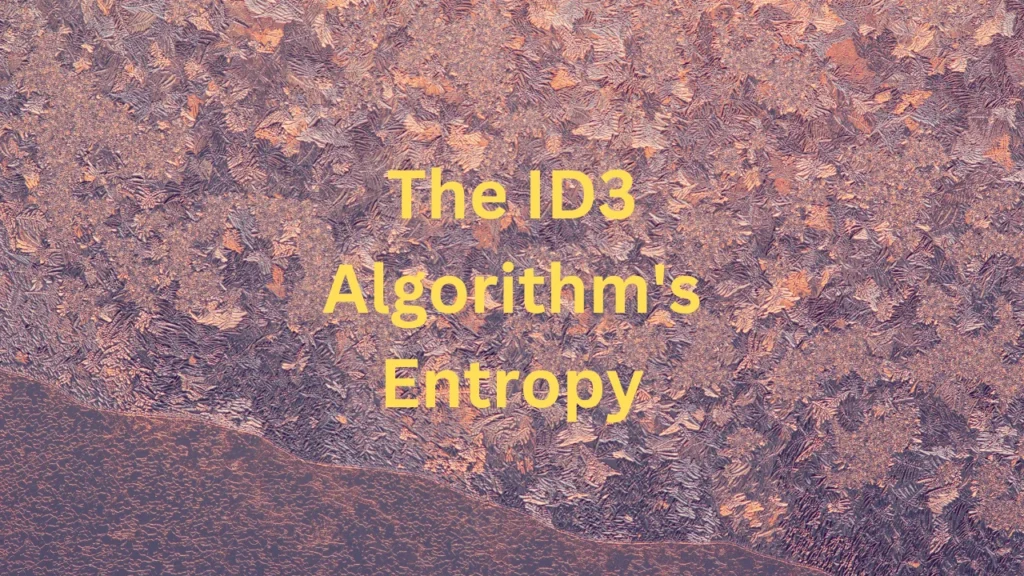Introduction
The development of numerous algorithms tailored to efficiently manage particular tasks has contributed to the meteoric rise of data mining and machine learning as a whole. Among these algorithms, the ID3 algorithm in data mining is particularly noteworthy for its groundbreaking approach to decision tree construction, which is essential for classification tasks. A major step forward in machine learning, it was created by Ross Quinlan and offers a straightforward method for recursively partitioning datasets to construct decision trees.
What is the ID3 Algorithm?
Data mining classification tasks are handled by the ID3 algorithm, a decision tree algorithm. It is a Ross Quinlan invention that constructs a decision tree from data using a greedy, top-down method. Every time the dataset is split, the algorithm chooses the attribute that maximises information gain, making sure that the entropy or impurity is reduced the most.
Decision Tree Construction

Understanding Decision Trees
Classification and regression are two applications of the predictive modelling algorithm known as decision trees. Attributes are represented by nodes, decision rules by branches, and outcomes by leaf nodes in the tree structure. Attributes are represented by the internal nodes, and class labels are represented by the leaf nodes.
Steps in Building a Decision Tree
First, choose an attribute that will help you divide your data into manageable chunks. An attribute’s efficacy in classifying the training data is evaluated by the ID3 algorithm using information gain.
After the attribute is chosen, the dataset is divided into subsets. There are instances in each subset that have the same value for the chosen attribute. For every subset, this procedure is iterated recursively.
A node is produced for every subset that was generated in the previous step, and branches are drawn for every possible value of the chosen attribute. Iteratively, this procedure is carried out.
Recursive partitioning keeps going until something stops it. Instances in a subset may all be members of the same class, or there may be insufficient attributes to divide the data further.
A decision tree’s accuracy and efficacy are assessed after construction through evaluation with test data.
The ID3 Algorithm’s Entropy

A Theory on Entropy
The entropy of a dataset is a measure of its inherent uncertainty or impurity derived from the field of information theory. If you’re working with decision trees, entropy can help you choose the right attribute to use for data splitting. At each split, we aim to decrease entropy and increase subset purity.
Calculating Entropy
The formula for calculating entropy is:
The equation for the entropy of a random variable, 𝑆, is given by 𝑁=1𝑛𝑝𝑖log2(𝑝𝑖).
You can write the entropy of S as −∑
Role of Entropy in Attribute Selection
The ID3 algorithm chooses the optimal attribute for dataset splitting by calculating information gain from entropy. Because it minimises entropy and, by extension, dataset uncertainty, the attribute that yields the most information gain is selected.
Entropy and Information Gain
When data is partitioned according to an attribute, the entropy is reduced, which results in information gain. It is determined by subtracting the entropy of the dataset from its pre- and post-split values. To divide the data, we look for the attribute that yields the most useful information.
Challenges with Entropy Calculation
It can be computationally intensive to calculate entropy for big datasets. Overfitting is another possible outcome of attributes having a large number of values dominating the entropy calculation. Regardless of these obstacles, entropy is still an important idea in the ID3 algorithm for creating good decision trees.
Information Gain in ID3
Definition of Information Gain
To find out which attribute distinguishes the training examples most effectively in relation to their intended classification, one can use the information gain metric. It relies on the fact that entropy decreases when datasets are partitioned according to an attribute.
Calculating Information Gain
Information gain is calculated using the formula:
The information gain between 𝑆 and 𝐴 is equal to the entropy of 𝑆 minus the sum of all 𝑎 values in 𝐴.
Gain of Information (S, A)=Entropy(S) – sum of all
v∈Values(A)
Importance of Information Gain
Acquiring more knowledge aids in picking the feature that drastically cuts down on uncertainty. This makes sure that the dataset is split into the most similar subsets every time, which helps the decision tree perform better.
Examples of Information Gain Calculation
Think of a dataset where attributes include things like play decisions (whether to play or not) and weather conditions. In order to choose the most informative attribute for data splitting, it is helpful to calculate the information gain for each attribute. This will help in developing the best decision tree.
Challenges with Information Gain
Overfitting is a potential issue with information gain because it favours attributes with many values. In order to tackle this, more complex algorithms such as C4.5 occasionally employ alternative metrics like gain ratio.
Greedy Approach in ID3
Definition of the Greedy Approach
Decision trees are constructed using a greedy approach by the ID3 algorithm. In other words, it iteratively seeks the global optimum by making the best decision at each step. At each node, the algorithm chooses the attribute that yields the most information gain.
Steps in the Greedy Approach
The algorithm considers all the attributes at each node and chooses the best one based on the information gain.
The next step is to divide the dataset into more homogeneous subsets according to the chosen attribute.
In order to create a tree structure that divides the dataset into subsets that are more and more pure, the process is repeated recursively for each subset.
Advantages of the Greedy Approach
The ID3 algorithm is straightforward and easy to implement because of the greedy approach, which is both simple and efficient. It is well-suited to datasets where speed is paramount due to its rapid convergence on a solution.
Limitations of the Greedy Approach
The main problem with the greedy method is that it can’t ensure the best solution on a global scale. If the initial selection of attributes is not ideal, it can result in trees that are not optimal. Overfitting is another potential outcome of the greedy approach, especially when dealing with complicated or noisy datasets.
Overfitting in ID3 Algorithm
Understanding Overfitting
The problem of overfitting arises when a model gets overly complicated and begins to identify patterns in the training data as noise or random fluctuations. Poor generalisation to new, unseen data results from this.
Causes of Overfitting in ID3
If the training data contains a large number of attributes and values, the ID3 algorithm is capable of producing trees with a great number of nodes and branches.
The algorithm might fit outliers in the training data, making the model underperforming when presented with new data.
If the training dataset is too small, the algorithm might produce a perfect tree fit, but it won’t be able to generalise.
Techniques to Prevent Overfitting
When a tree is pruned, branches that do not significantly contribute to the prediction of the target variables are removed. To achieve this, you can use cross-validation or establish a threshold for the amount of information you want to gain.
Overfitting can be prevented by using simpler models. One way to do this is to limit the number of nodes or the depth of the tree.
If you want to make sure your model does well on data it has never seen before, you should use cross-validation, which is dividing your dataset into a training set and a validation set. By doing so, overfitting can be more easily detected and mitigated.
Impact of Overfitting on Model Performance
If a model is overfit, it will do very well on training data but very badly on test data. It is crucial to tackle overfitting when using the ID3 algorithm to build decision trees, as it diminishes the model’s reliability and effectiveness in real-world applications.
Attribute Selection in ID3
Importance of Attribute Selection
Because it establishes the foundation and efficacy of the decision tree, attribute selection is an essential part of the ID3 algorithm. To improve classification accuracy, it is necessary to choose attributes that yield the most useful information.
Criteria for Selecting Attributes
Information Gain: The ID3 algorithm uses information gain as its main criterion for selecting attributes. When dividing the dataset, we look for attributes that reduce entropy the most.
Consideration of Attribute Relevance: Preference is given to attributes that are more pertinent to the target variable. Domain knowledge or statistical measures can be used to determine this.
Handling Attributes with Many Values
Overfitting can occur when attributes with many values dominate the calculation of information gain. This can be remedied by employing techniques such as gain ratio, which normalises information gain according to the attribute’s intrinsic information.
Examples of Attribute Selection
For the purpose of forecasting loan approval, let’s imagine a dataset with characteristics such as age, income, and degree of education. Each attribute’s information gain is determined, and the data is split based on the one with the highest gain.
Challenges in Attribute Selection
When dealing with complicated and large datasets, it can be particularly difficult to choose the appropriate attributes. Suboptimal trees can result from focusing too narrowly on a single metric, such as information gain. Enhancing attribute selection can be achieved by utilising advanced techniques such as gain ratio and combining multiple criteria.
Ross Quinlan’s
Development of the ID3 Algorithm
In an effort to streamline the process of building decision trees, Ross Quinlan created the ID3 algorithm in the late 1970s. His contributions greatly advanced machine learning and served as a springboard for many later algorithms.
Contributions to Machine Learning
The idea of using information gain for attribute selection, first introduced by Quinlan’s ID3 algorithm, is now foundational in decision tree construction. Decision trees could be applied to classification tasks in his work, which provided a transparent and understandable model.
Evolution of Decision Tree Algorithms
Quinlan kept working to make decision tree algorithms better after ID3 was developed. In response to ID3’s shortcomings, he created the C4.5 algorithm, which handles continuous attributes and prunes trees to prevent overfitting, among other things. A number of current decision tree algorithms, such as CART, can trace their roots back to his work (Classification and Regression Trees).
Impact on Data Mining and Machine Learning
Decision tree algorithms developed by Quinlan are cornerstones of modern data mining and ML. Because of their effectiveness, simplicity, and interpretability, decision trees continue to be one of the most researched and used methods in these areas.
Legacy of Ross Quinlan
Ross Quinlan is widely recognised as a trailblazer in the field of machine learning for his groundbreaking contributions, most notably the ID3 algorithm. Decision trees are now standard equipment for any classification job thanks to his contributions to the fields of data mining and machine learning.
Classification Tasks
Role of ID3 in Classification
Data mining classification tasks are the main applications of the ID3 algorithm. By tracing the relationships between nodes in a decision tree according to the values of attributes, it can be used to categorise new instances.
Examples of Classification Tasks
Classifying patients according to their symptoms and medical history allows the ID3 algorithm to forecast the probability of specific diseases in medical diagnosis.
ID3’s marketing capabilities allow for the categorization of customers into distinct groups according to characteristics such as age, income, and buying habits.
ID3 allows banks to sort loan applications according to applicant details like income, employment history, and credit score.
Advantages of Using ID3 for Classification
The ID3 algorithm generates a decision tree model that is easy to understand and work with. Because of this, the classification decisions can be readily explained and understood. On top of that, the algorithm works well for a variety of classification jobs because it is both simple and efficient.
Challenges in Classification with ID3
When it comes to classification tasks, the ID3 algorithm does have its limitations, despite all its benefits. When dealing with complicated or noisy datasets, it may lead to overfitting. Furthermore, the algorithm has a propensity to prioritise attributes with a high value, resulting in trees that are less than ideal.
Intelligent data collection
Machine Learning Integration
Machine learning relies heavily on the ID3 algorithm, which is especially useful when building decision trees to handle classification problems. Machine learning frameworks and algorithms that are more sophisticated now incorporate its ideas.
Educational Resources for Learning
There are a plethora of books, videos, and websites that can help you learn the ID3 algorithm. These resources offer a thorough grasp of the algorithm by covering both its theoretical concepts and its practical implementation.
Implementing ID3 in Python
Many machine learning algorithms, like ID3, are implemented in Python. The ID3 algorithm can be more easily implemented and experimented with with libraries such as scikit-learn, which offer functions and tools for building decision trees.
Comparing ID3 with Other Algorithms
When compared to other decision tree algorithms, such as C4.5 and CART, the ID3 algorithm stands out. It is possible to select the best algorithm for a specific job by being familiar with its advantages and disadvantages.
Case Studies Using ID3
You can see the ID3 algorithm in action in many different industries, from healthcare to finance to marketing, thanks to the abundance of case studies. You can see how the algorithm works in real-world situations and how well it solves classification problems in these case studies.
Frequently Asked Questions
How does the ID3 algorithm work in decision tree construction?
The ID3 algorithm works by recursively splitting the dataset based on the attribute that provides the highest information gain. It uses a top-down, greedy approach to construct a decision tree that partitions the data into increasingly pure subsets.
Comparing ID3, C4.5, and CART algorithms in machine learning
ID3, C4.5, and CART are all decision tree algorithms used for classification tasks. ID3 uses information gain for attribute selection, while C4.5 uses gain ratio to address some of ID3’s limitations. CART, on the other hand, can handle both classification and regression tasks and uses the Gini index for attribute selection.
Techniques to prevent overfitting in the ID3 algorithm
Techniques to prevent overfitting in the ID3 algorithm include pruning, limiting the depth of the tree, and using cross-validation. These methods help in creating simpler models that generalize better to new data.
The role of entropy and information gain in ID3
Entropy measures the impurity or disorder in a dataset, while information gain quantifies the reduction in entropy achieved by splitting the data on an attribute. The ID3 algorithm uses these concepts to select the best attributes for constructing a decision tree.
Implementing the ID3 algorithm in Python
Implementing the ID3 algorithm in Python involves using libraries like scikit-learn, which provide tools for constructing decision trees. The process includes loading the dataset, calculating entropy and information gain, and recursively building the tree.
Also Read: Graphite Mining: A Detailed Information
Conclusion
When practitioners have a firm grasp of the ID3 algorithm and its uses in ML and data mining, they are better equipped to construct efficient decision trees and tackle a wide range of classification problems. The ID3 algorithm in data mining has its limitations, but it is still a crucial tool that has shaped many advanced techniques and is still used today.

Brandy Stewart, an enchanting wordsmith and seasoned blogger, weaves compelling narratives that transport readers to uncharted territories. Infused with perceptive viewpoints and dynamic storytelling, Doris exhibits a command of language that enthralls both hearts and minds, leaving a lasting mark on the literary panorama.

